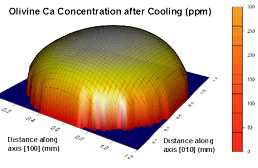The Ca-geospeedometer - A tool for investigating the processes that generate oceanic crust
- Started
- 30th June 2013
- Ended
- 15th March 2016

A 3D numerical model simulates internal calcium diffusion, with insulated centre regions preserving information on cooling rate of the rock, being lower the longer the crystal was at a high temperature with rapid diffusion. Numerical models are required
The formation of new oceanic lithosphere is the foundation of the plate tectonic cycle. Implicit to understanding this fundamental process is resolving the thermal evolution of the ocean crust, but the locations of magma crystallization and the extent of heat transport by hydrothermal circulation during remain poorly understood. Trace calcium concentrations in olivine preserve information on past cooling rates of oceanic crustal rocks and ophiolites and can be exploited to provide insights into the thermal history of the lower ocean crust. Cooling rates estimated by published studies are difficult to compare due to the use of different geothermometers that link Ca concentrations to temperatures, diffusivity parameters, methods of analysis and calculation approaches. Large uncertainties stem from the limited constraints on physical parameters such as diffusivity.
Here we use novel 3D numerical simulations of anisotropic Ca diffusion during cooling of an olivine-clinopyroxene system to generate artificial Ca distributions to test and compare published methods and geothermometers. The most accurate method to calculate a cooling rate is to systematically match measured concentration profiles to the 3D numerical simulation, accounting fully for the anisotropic diffusion. However, the analytical solution used to date approximately recovers input cooling rates despite its assumption of isotropic diffusion through a sphere, so long as measurement location is accounted for accurately. Closure temperatures calculated from different experimentally defined geothermometers differ greatly due to different methods of fitting to low temperature equilibration experiments.
Monte Carlo simulations reveal that absolute uncertainties in cooling rate estimates remain large due to uncertainties in the experimental geothermometer calibrations and diffusivity parameters. This makes it difficult to compare cooling rates estimated from Ca-in-olivine diffusion with other mineral-derived rates or thermal models. However the uncertainties are systematic, and when we apply a consistent approach to different published datasets from the Samail ophiolite real differences in the estimated cooling rates and their depth variation remain.
Supervisors;
Dr James G Dyke (Institute for Complex Systems Simulation, University of Southampton)
Prof. Tim Henstock (Ocean and Earth Sciences, University of Southampton)
Prof. Damon Teagle (Ocean and Earth Sciences, University of Southampton)
Dr Michelle Harris (School of Geography, Earth and Environmental Sciences, Plymouth University)
Categories
Physical Systems and Engineering simulation: Diffusion, Earth surface dynamics, Geophysics, Heat transfer
Programming languages and libraries: C, Python, R
Transdisciplinary tags: Complex Systems, Scientific Computing